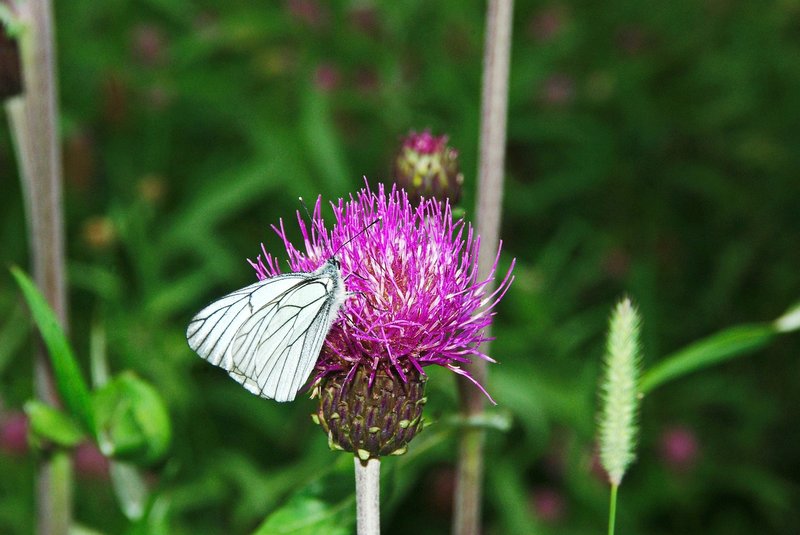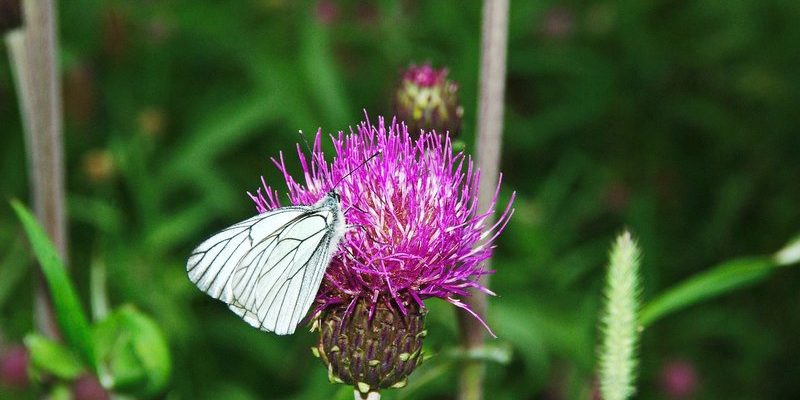
The Thistle Butterfly, also known as the Cardui butterfly, is a stunning creature that adds vibrant splashes of color to gardens and meadows. Imagine a living brushstroke gliding through the air, landing delicately on a flower’s petal, and you’ve got a picture of this enchanting insect. With its intricate patterns and fluttering grace, the Thistle Butterfly captures the hearts of many nature enthusiasts and casual observers alike.
These butterflies are not just beautiful; they play a crucial role in our ecosystem. As pollinators, they help plants reproduce by transferring pollen from one flower to another. This process is vital for the health of many plants, including those we rely on for food. So, the next time you spot a Thistle Butterfly enjoying a sunny day, remember there’s a lot more going on than just a pretty sight.
In this article, we’ll dive deep into the fascinating world of Thistle Butterflies. We’ll explore their habitat, life cycle, and even their dietary preferences. So, grab your favorite drink, and let’s flutter into the details!
Physical Characteristics of the Thistle Butterfly
The Thistle Butterfly is characterized by its striking patterns and colors. Typically, these butterflies sport a combination of orange, black, and white on their wings, which can be an eye-catching sight against the greenery of their habitats. The wingspan of an adult Thistle Butterfly ranges from approximately 1.5 to 3 inches. Female butterflies often have slightly larger wings compared to males, making them an interesting study in sexual dimorphism.
One of the most notable features of the Thistle Butterfly is the intricate patterns that adorn its wings. These patterns aren’t just for show; they serve a purpose. The bright colors help attract mates during the breeding season, while the darker shades provide some camouflage against predators. When threatened, the Thistle Butterfly can also exhibit a fluttering flight pattern, which can confuse predators and give it a chance to escape.
Another fascinating aspect of their physical traits is the fuzzy body, which helps in temperature regulation. Their bodies are covered in tiny scales that can absorb heat from the sun, allowing them to warm up quickly in the mornings before taking flight. This adaptation is essential, as it enables them to be active during the warmer parts of the day.
Habitat and Distribution
You might wonder where these beautiful butterflies call home. Thistle Butterflies are found in a variety of habitats, from open fields and meadows to gardens and wetlands. They thrive in areas where thistles and other flowering plants are abundant, as these provide both food and breeding grounds. This adaptability allows them to be widespread across North America, Europe, and parts of Asia.
The presence of flowers is crucial for Thistle Butterflies. They are particularly fond of nectar-rich plants such as thistles, sunflowers, and milkweed. These plants not only provide the necessary nutrients for adult butterflies but are also essential for their caterpillars. Without an adequate supply of these plants, Thistle Butterfly populations can decline rapidly, which is a concern for conservationists.
Seasonal migrations also play a significant role in their habitat needs. During summer, you might find them in higher elevations, moving downward as the weather changes. This migration helps them escape harsh conditions and find suitable environments. Thus, the Thistle Butterfly’s habitat is dynamic and fluctuates with seasonal changes, showcasing their resilience in adapting to different environments.
Diet and Feeding Habits
What do Thistle Butterflies eat? As nectar feeders, their diet primarily consists of sweet liquids from various flowers. They have a long proboscis, which allows them to sip nectar from deep within blossoms. This feeding behavior is essential for their survival, providing the energy needed for their active lifestyle.
Interestingly, Thistle Butterflies are not picky eaters. They have a broad palate and will feed on the nectar of many different plants. Common favorites include thistles, daisies, and a variety of wildflowers. This diversity in their diet helps them thrive in varied environments but also highlights the importance of preserving natural habitats filled with flowering plants.
As caterpillars, Thistle Butterflies have a different diet. They predominantly feed on the leaves of thistle plants. This early life stage is crucial for their development, as they require ample nutrition to grow and eventually metamorphose into butterflies. The connection between the caterpillars and their host plants not only supports the individual butterfly but also impacts the ecosystem, as healthy populations of Thistle Butterflies can promote a rich biodiversity in their habitats.
Life Cycle of the Thistle Butterfly
The life cycle of the Thistle Butterfly is a fascinating journey that begins with the egg stage. Females lay tiny, round eggs on the undersides of thistle leaves. When the time comes, these eggs hatch into hungry caterpillars, also known as larvae. These little critters are often green or brown, which helps them blend into their surroundings as they munch on thistle leaves.
Caterpillars go through several molts, shedding their skin as they grow. This stage can last a few weeks, depending on environmental conditions and food availability. Once they have reached a sufficient size, the caterpillars enter the pupal stage, where they transform into chrysalises. During this period, which can last anywhere from a week to several months, they undergo a remarkable metamorphosis.
Finally, the adult Thistle Butterfly emerges from the chrysalis, ready to take on the world. This part of the life cycle is particularly breathtaking, as the freshly emerged butterflies pump fluid into their wings, allowing them to expand and dry before taking flight. Once they’re fully ready, these butterflies will begin the cycle anew, seeking out mates and laying eggs to continue their lineage.
Threats and Conservation
Like many species, the Thistle Butterfly faces challenges in the wild. Habitat loss is one of the most significant threats they encounter, primarily due to urbanization, agriculture, and pesticide use. As more natural areas are developed or altered, the essential plants that support their life cycle become scarcer, making it difficult for these butterflies to thrive.
Pesticides also pose a considerable risk. While they aim to control pests, they can inadvertently harm non-target species like the Thistle Butterfly. Exposure to these chemicals can disrupt their life cycle, leading to decreased populations. Therefore, fostering awareness about butterfly-friendly gardening practices can play an important role in conservation efforts.
Fortunately, several conservation groups are working to protect these beautiful butterflies and their habitats. Initiatives often include planting native flowers, creating butterfly gardens, and promoting organic farming practices. By raising awareness and taking proactive measures, we can help ensure that future generations will continue to enjoy the beauty of the Thistle Butterfly.
Fun Facts About the Thistle Butterfly
- Colorful Identity: Each butterfly has unique patterns, making no two Thistle Butterflies identical.
- Impressive Lifespan: Depending on the climate, Thistle Butterflies can live up to a few months, especially in cooler regions.
- Migratory Marvels: In some areas, they may migrate to avoid harsh winter conditions, showcasing their adaptability.
- Pollinator Power: Thistle Butterflies play a crucial role in pollinating many flowering plants, contributing to biodiversity.
FAQ
Where can I find Thistle Butterflies?
Thistle Butterflies can be found in various habitats, from gardens and meadows to fields and wetlands. They thrive in areas with abundant flowering plants, particularly thistles. If you’re looking to spot one, try visiting local parks or nature reserves during warm months when they are most active.
What do Thistle Butterflies symbolize?
Thistle Butterflies often symbolize change and transformation due to their fascinating life cycle, which includes metamorphosis from caterpillar to butterfly. They are also seen as symbols of beauty and resilience, reminding us of the importance of nature in our lives.
How long does the Thistle Butterfly live?
Thistle Butterflies have varying lifespans depending on their environment. On average, they can live for a few weeks to a couple of months. In cooler climates, some may even survive through the winter by entering a dormant state, extending their life cycle.
Are Thistle Butterflies harmful to plants?
No, Thistle Butterflies are not harmful to plants. In fact, they play a beneficial role in ecosystems as pollinators. While their caterpillars feed on thistle leaves, they do not pose a significant threat to plant health and contribute positively to biodiversity.
Do Thistle Butterflies migrate?
Yes, Thistle Butterflies are known to migrate, primarily in search of more favorable conditions during seasonal changes. This behavior helps them avoid extreme weather and find new habitats rich in food sources. Their migration patterns can vary depending on the region.
How can I attract Thistle Butterflies to my garden?
If you want to attract Thistle Butterflies, consider planting a variety of native flowering plants such as thistles, sunflowers, and milkweed. Providing a sunny spot, along with water sources like shallow dishes, can also make your garden more inviting for these beautiful butterflies.
What should I do if I find an injured Thistle Butterfly?
If you come across an injured Thistle Butterfly, it’s best to gently place it in a safe, quiet spot away from predators. Providing food sources like sugar water or nectar from flowers can help if it’s okay to eat. If the butterfly appears severely injured, contacting a local wildlife rehabilitation center is advisable.

